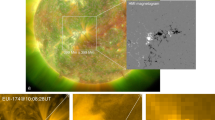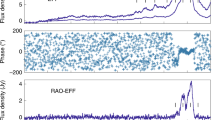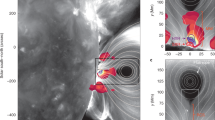Abstract
Magnetic reconnection is one of the most important processes in astrophysical, space and laboratory plasmas. Identifying the structure around the point at which the magnetic field lines break and subsequently reform, known as the magnetic null point, is crucial to improving our understanding of reconnection. But owing to the inherently three-dimensional nature of this process, magnetic nulls are only detectable through measurements obtained simultaneously from at least four points in space. Using data collected by the four spacecraft of the Cluster constellation as they traversed a diffusion region in the Earth's magnetotail on 15 September 2001, we report here the first in situ evidence for the structure of an isolated magnetic null. The results indicate that it has a positive-spiral structure whose spatial extent is of the same order as the local ion inertial length scale, suggesting that the Hall effect could play an important role in 3D reconnection dynamics.
This is a preview of subscription content, access via your institution
Access options
Subscribe to this journal
Receive 12 print issues and online access
$209.00 per year
only $17.42 per issue
Buy this article
- Purchase on Springer Link
- Instant access to full article PDF
Prices may be subject to local taxes which are calculated during checkout




Similar content being viewed by others
References
Giovanelli, R. G. A theory of chromospheric flares. Nature 158, 81–82 (1946).
Dungey, J. W. Cosmic Electrodynamics (Cambridge Univ. Press, Cambridge, 1958).
Dungey, J. W. Interplanetary magnetic field and the auroral zones. Phys. Rev. Lett. 6, 47–48 (1961).
Dungey, J. W. in Geophysics, The Earth's Environment (ed. Dewitt, C.et al.) 526–531 (Gordon and Breach, New York, 1963).
Parker, E. N. Sweet's mechanism for merging magnetic fields in conducting fluid. J. Geophys. Res. 62, 509–520 (1957).
Petschek, H. E. in The Physics of Solar Flare (ed. Hess, W. N.) 425–437 (NASA SP-50, NASA, Washington DC, 1964).
Birn, J. et al. Geospace environmental modeling (GEM) magnetic reconnection challenge. J. Geophys. Res. 106, 3715–3719 (2001).
Phan, T. D. et al. Extended magnetic reconnection at the earth's magnetopause from detection of bi-directional jets. Nature 404, 848–850 (2000).
Deng, X. H. & Matsumoto, H. Rapid magnetic reconnection in the Earth's magnetosphere generated by whistler waves. Nature 410, 557–559 (2001).
Øieroset, M. et al. In situ detection of collisionless reconnection in the earth's magnetotail. Nature 412, 414–417 (2001).
Mozer, F. S., Bale, S. D. & Phan, T. D. Evidence of diffusion regions at a subsolar magnetopause crossing. Phys. Rev. Lett. 89, 015002 (2002).
Frey, H. U., Phan, T. D., Fuselier, S. A. & Mende, S. B. Continuous magnetic reconnection at Earth's magnetopause. Nature 426, 533–536 (2003).
Priest, E. R. & Titov, V. S. Magnetic reconnection at three-dimensional null points. Phil. Trans. R. Soc. Lond. A 354, 2951–2992 (1996).
Cowley, S. W. H. A qualitatively study of the reconnection between the Earth's magnetic field and an interplanetary field of arbitrary orientation. Radio Sci. 8, 903–913 (1973).
Lau, Y.-T. & Finn, J. M. Three-dimensional kinematic reconnection in the presence of field nulls and closed field lines. Astrophys. J. 350, 672 (1990).
Priest, E. R. & Forbes, T. G. Magnetic Reconnection: MHD Theory and Applications (Cambridge Univ. Press, New York, 2000).
Priest, E. R., Hornig, G. & Pontin, D. I. On the nature of three-dimensional magnetic reconnection. J. Geophys. Res. 108,(2003) doi:10.1029/2002JA009812.
Buchner, J. Three-dimensional magnetic reconnection in astrophysical plasma–-kinetic approach. Astrophys. Space Sci. 264, 25–42 (1999).
Lui, A. T. Y. Critical issues on magnetic reconnection in space plasmas. Space Sci. Rev. 116, 497–521 (2005).
Arnold, V. I. Ordinary Differential Equation (Springer, Berlin, New York, 1992).
Wang, J. Vector magnetic field and magnetic activity on the Sun. Fund. Cosmic Phys. 20, 251–382 (1999).
Greene, J. M. Geometrical properties of 3D reconnecting magnetic fields with nulls. J. Geophys. Res. 93, 8583–8590 (1988).
Schindler, K., Hesse, M. & Birn, J. General reconnection, parallel electric fields and helicity. J. Geophys. Res. 93, 5547–5557 (1988).
Wang, X. G. & Bhattacharjee, A. A three-dimensional reconnection model of the magnetosphere: Geometry and kenematics. J. Geophys. Res. 101, 2641–2653 (1996).
Greene, J. M. & Miller, R. L. Proceedings of the International Symposium in Honor of Bruno Coppi (Report GAA21961) (General Atomics, San Diego, 1995).
Hu, S., Bhattacharjee, A., Dorelli, J. & Greene, J. M. The spherical tearing mode. Geophys. Res. Lett. 31, L19806 (2004).
Galsgaard, K. & Nordlund, A. Heating and activity of the solar corona: 3. Dynamics of a low-beta plasma with three-dimensional null points. J. Geophys. Res. 102, 231–248 (1997).
Lau, Y.-T. & Finn, J. M. Magnetic reconnection and the topology of interacting twisted flux tubes. Phys. Plasmas 3, 3983–3997 (1996).
Pontin, D. I., Hornig, G. & Priest, E. R. in Proceedings of the SOHO 15 Workshop–Coronal Heating (ed. Walsh, R. W.et al.) 507–523 (ESA Publications Division, Noordwijk, 2004).
Parnell, C. E., Smith, J. M., Neukirch, T. & Priest, E. R. The structure of three-dimensional magnetic neutral points. Phys. Plasmas 3, 759–770 (1996).
Filippov, B. Observation of a 3D magnetic null point in the solar corona. Sol. Phys. 185, 297–309 (1999).
Aulanier, G. et al. The topology and evolution of the Bastille day flare. Astrophys. J. 540, 1126–1146 (2000).
Fletcher, L. et al. Evidence for the flare trigger site and three-dimensional reconnection in multiwavelength observations of a solar flare. Astrophys. J. 554, 451–463 (2001).
Zhao, H., Wang, J., Zhang, J. & Xiao, C. J. A new method of identifying 3D null points in solar vector magnetic fields. Chin. J. Astron. Astrophys. 5, 443–447 (2005).
Garth, C., Tricoche, X. & Scheuermann, G. in Proceedings of IEEE Visualization '04 (ed. Rushmeier, H.et al.) 329–336 (IEEE Computer Society, Washington DC, 2004).
Ding, W. X. Measurement of internal magnetic field fluctuations in a reversed-field pinch by Faraday rotation. Phys. Rev. Lett. 90, 035002 (2003).
Escoubet, C. P., Schmidt, R. & Goldstein, M. L. in The Cluster and Phoenix Missions (ed. Escoubet, C. P.et al.) 11–32 (Kluwer Academic, Dordrecht, 1997).
Balogh, A. et al. in The Cluster and Phoenix Missions (ed. Escoubet, C. P.et al.) 65–92 (Kluwer Academic, Dordrecht, 1997).
Reme, H. et al. in The Cluster and Phoenix Missions (ed. Escoubet, C. P.et al.) 303–350 (Kluwer Academic, Dordrecht, 1997).
Greene, J. M. Locating three-dimensional roots by a bisect ion method. J. Comput. Phys. 98, 194–198 (1992).
Cai, D. S., Li, Y. T., Ichikawai, T., Xiao, C. J. & Nishikawa, K. Visualization and criticality of magnetotail field topology in a three-dimensional particle simulation. Earth, Planets Space 53, 1011 (2001).
Sonnerup, B. U. O. & Scheible, M. in Analysis Methods for Multi-Spacecraft Data. (eds Paschmann, G. & Daly, P. W.) 185–220 (ESA Publications Division, Noordwijk, 1998).
Khurana, K. K. et al. Accurate determination of magnetic field gradients from four-point vector measurements-II: use of nutral constraints on vector data obtained from four spinning spacescraft. IEEE Trans. Magn. 32, 5193–5205 (1996).
Chanteur, G. in Analysis Methods for Multi-Spacecraft Data (eds Paschmann, G. & Daly, P. W.) 349–369 (ESA Publications Division, Noordwijk, 1998).
Xiao, C. J. et al. Multiple magnetic reconnection events observed by Cluster: current calculating. Chin. J. Geophys. 47, 635–643 (2004).
Wang, X. G., Bhattacharjee, A. & Ma, Z. W. Collisionless reconnection: effects of Hall current and electron pressure gradient. J. Geophys. Res. 105, 27633 (2000).
Wang, X. G., Bhattacharjee, A. & Ma, Z. W. Scaling of collisionless forced reconnection. Phys. Rev. Lett. 87, 265003 (2001).
Acknowledgements
This work is supported by the NSFC Programs (Grant Nos 40390150, 4050421, 10233050, 10575018, 40536030, 40425004, and 40228006) and the China Key Research Project (Grant No. G200000784), as well as the China Double Star-Cluster Science Team. The authors also thank D. S. Cai, E. R. Priest, and G. P. Zhou for helpful discussions and suggestions, as well as H. Schwarzl for producing the intercalibrated FGM data.
Author information
Authors and Affiliations
Corresponding author
Ethics declarations
Competing interests
The authors declare no competing financial interests.
Rights and permissions
About this article
Cite this article
Xiao, C., Wang, X., Pu, Z. et al. In situ evidence for the structure of the magnetic null in a 3D reconnection event in the Earth's magnetotail. Nature Phys 2, 478–483 (2006). https://doi.org/10.1038/nphys342
Received:
Accepted:
Published:
Issue Date:
DOI: https://doi.org/10.1038/nphys342
This article is cited by
-
Circular-ribbon flares and the related activities
Reviews of Modern Plasma Physics (2024)
-
Recent progress on magnetic reconnection by in situ measurements
Reviews of Modern Plasma Physics (2023)
-
Magnetic reconnection: MHD theory and modelling
Living Reviews in Solar Physics (2022)
-
Particle energization in space plasmas: towards a multi-point, multi-scale plasma observatory
Experimental Astronomy (2022)
-
Mission Oriented Support and Theory (MOST) for MMS—the Goddard Space Flight Center/University of California Los Angeles Interdisciplinary Science Program
Space Science Reviews (2016)



